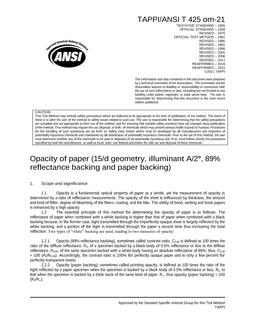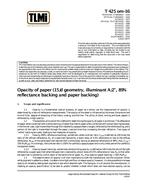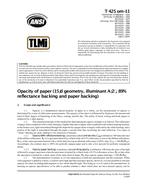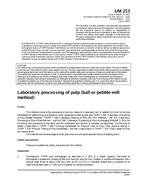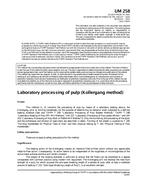TAPPI T 425 – Opacity of paper (15/d geometry, illuminant A/2*, 89% reflectance backing and paper backing)
Opacity is a fundamental optical property of paper as a whole, yet the measurement of opacity is determined by a ratio of reflectance measurements. The opacity of the sheet is influenced by thickness, the amount and kind of filler, degree of bleaching of the fibers, coating, and the like. The utility of bond, writing and book papers is enhanced by a high opacity.
The essential principle of this method for determining the opacity of paper is as follows: The reflectance of paper when combined with a white backing is higher than that of paper when combined with a black backing because, in the former case, light transmitted through the imperfectly opaque sheet is largely reflected by the white backing, and a portion of the light is transmitted through the paper a second time thus increasing the total reflection. Two types of white backing are used, leading to two measures of opacity:
Opacity (89% reflectance backing), sometimes called contrast ratio, C0.89 is defined as 100 times the ratio of the diffuse reflectance, R0, of a specimen backed by a black body of 0.5% reflectance or less to the diffuse reflectance, R0.89, of the same specimen backed with a white body having an absolute reflectance of 89%; thus, C0.89 = 100 (R0/R0.89). Accordingly, the contrast ratio is 100% for perfectly opaque paper and is only a few percent for perfectly transparent sheets.
Opacity (paper backing), sometimes called printing opacity, is defined as 100 times the ratio of the light reflected by a paper specimen when the specimen is backed by a black body of 0.5% reflectance or less, R0, to that when the specimen is backed by a thick stack of the same kind of paper, R; thus opacity (paper backing) = 100 (R0/R).
The determination of opacity is of vital importance to both the manufacturer and the consumer. When white pigment is added to a sheet, it scatters more light and thus increases opacity; however, it is also possible to increase opacity of a sheet by adding dark pigment or dye which absorbs light. This being so, it is of value to the manufacturer, in meeting an opacity specification, to be able to predict whether a sheet which does not have desired opacity can be brought up to specification by raising or, alternatively, lowering the reflectivity within permissible limits. To the consumer, opacity measurements are used to evaluate some of the characteristics of appearance. The user is interested in the comparison of samples under identical conditions. When comparisons are made, one sample with another, very small differences can be identified visually. For this reason, small measured differences between similar samples represent actual differences in appearance.
This method employs 15/d geometry, illuminant A/2 and 89% reflectance backing or paper backing.
For the measurement of opacity with d/0 geometry, illuminant C/2 and paper backing, see TAPPI T 519.
Product Details
- Published:
- 2021
- ANSI:
- ANSI Approved
- Number of Pages:
- 7
- File Size:
- 1 file , 260 KB
- Note:
- This product is unavailable in Ukraine, Russia, Belarus

